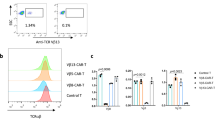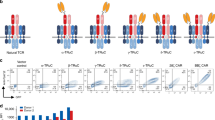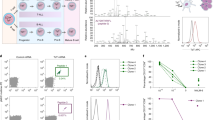Abstract
Chimeric receptors bearing ligand recognition domains linked to signaling regions from the T-cell receptor can redirect T lymphocytes against non-MHC-restricted targets. Cytolytic T lymphocytes (CTL) expressing these chimeric receptors are being tested in preclinical and clinical trials for activity in cancer, infectious diseases and autoimmunity. The chimeric receptors may incorporate antigenic epitopes previously unrecognized by the immune system. Whether a receptor-specific antibody response develops to these neoantigens and whether such a response inhibits therapeutic cell activity is unknown. We hypothesized that upon engagement of a chimeric receptor-specific B cell, receptor-modified CTL will be activated, lysing the B cell and inducing tolerance to the chimeric receptor rather than immunity. We demonstrate that receptor-modified CTL are indeed stimulated by cognate receptor-specific B cells, proliferate and produce cytokines in response and kill the B cells in vitro and in vivo. However, this is insufficient to induce full B-cell tolerance. Modified CTL induce a chimeric receptor-specific antibody response independent of any other source of antigen. Nevertheless, the CTL retain substantial activity even in the presence of saturating doses of receptor-specific antibody. Thus antichimeric receptor antibody responses need to be considered in the clinical use of chimeric receptor-modified T cells. However, the inhibitory activity of these antibodies may in cases be limited.
This is a preview of subscription content, access via your institution
Access options
Subscribe to this journal
Receive 12 print issues and online access
$259.00 per year
only $21.58 per issue
Buy this article
- Purchase on Springer Link
- Instant access to full article PDF
Prices may be subject to local taxes which are calculated during checkout







Similar content being viewed by others
References
Tey SK, Bollard CM, Heslop HE . Adoptive T-cell transfer in cancer immunotherapy. Immunol Cell Biol 2006; 84: 281–289.
Gattinoni L, Powell Jr DJ, Rosenberg SA, Restifo NP . Adoptive immunotherapy for cancer: building on success. Nat Rev Immunol 2006; 6: 383–393.
Riddell SR, Greenberg PD . Principles for adoptive T cell therapy of human viral diseases. Annu Rev Immunol 1995; 13: 545–586.
Starr TK, Jameson SC, Hogquist KA . Positive and negative selection of T cells. Annu Rev Immunol 2003; 21: 139–176.
Janeway Jr CA . The T cell receptor as a multicomponent signalling machine: CD4/CD8 coreceptors and CD45 in T cell activation. Annu Rev Immunol 1992; 10: 645–674.
Rossig C, Brenner MK . Chimeric T-cell receptors for the targeting of cancer cells. Acta Haematol 2003; 110: 154–159.
Geiger TL, Jyothi MD . Development and application of receptor-modified T lymphocytes for adoptive immunotherapy. Transfus Med Rev 2001; 15: 21–34.
Roberts MR, Qin L, Zhang D, Smith DH, Tran AC, Dull TJ et al. Targeting of human immunodeficiency virus-infected cells by CD8+ T lymphocytes armed with universal T-cell receptors. Blood 1994; 84: 2878–2889.
Sadelain M, Riviere I, Brentjens R . Targeting tumours with genetically enhanced T lymphocytes. Nat Rev Cancer 2003; 3: 35–45.
Jyothi MD, Flavell RA, Geiger TL . Targeting autoantigen-specific T cells and suppression of autoimmune encephalomyelitis with receptor-modified T lymphocytes. Nat Biotechnol 2002; 20: 1215–1220.
Nguyen P, Geiger TL . Antigen-specific targeting of CD8(+) T cells with receptor-modified T lymphocytes. Gene Therapy 2003; 10: 594–604.
Mekala DJ, Geiger TL . Immunotherapy of autoimmune encephalomyelitis with redirected CD4+CD25+ T lymphocytes. Blood 2005; 105: 2090–2092.
Mitsuyasu RT, Anton PA, Deeks SG, Scadden DT, Connick E, Downs MT et al. Prolonged survival and tissue trafficking following adoptive transfer of CD4zeta gene-modified autologous CD4(+) and CD8(+) T cells in human immunodeficiency virus-infected subjects. Blood 2000; 96: 785–793.
Kershaw MH, Westwood JA, Parker LL, Wang G, Eshhar Z, Mavroukakis SA et al. A phase I study on adoptive immunotherapy using gene-modified T cells for ovarian cancer. Clin Cancer Res 2006; 12 (20 Part 1): 6106–6115.
Deeks SG, Wagner B, Anton PA, Mitsuyasu RT, Scadden DT, Huang C et al. A phase II randomized study of HIV-specific T-cell gene therapy in subjects with undetectable plasma viremia on combination antiretroviral therapy. Mol Ther 2002; 5: 788–797.
Walker RE, Bechtel CM, Natarajan V, Baseler M, Hege KM, Metcalf JA et al. Long-term in vivo survival of receptor-modified syngeneic T cells in patients with human immunodeficiency virus infection. Blood 2000; 96: 467–474.
Stripecke R, Carmen VM, Skelton D, Satake N, Halene S, Kohn D . Immune response to green fluorescent protein: implications for gene therapy. Gene Therapy 1999; 6: 1305–1312.
Cahalan MD, Parker I . Close encounters of the first and second kind: T-DC and T-B interactions in the lymph node. Semin Immunol 2005; 17: 442–451.
Kowolik CM, Topp MS, Gonzalez S, Pfeiffer T, Olivares S, Gonzalez N et al. CD28 costimulation provided through a CD19-specific chimeric antigen receptor enhances in vivo persistence and antitumor efficacy of adoptively transferred T cells. Cancer Res 2006; 66: 10995–11004.
Moeller M, Haynes NM, Trapani JA, Teng MW, Jackson JT, Tanner JE et al. A functional role for CD28 costimulation in tumor recognition by single-chain receptor-modified T cells. Cancer Gene Ther 2004; 11: 371–379.
Krause A, Guo HF, Latouche JB, Tan C, Cheung NK, Sadelain M . Antigen-dependent CD28 signaling selectively enhances survival and proliferation in genetically modified activated human primary T lymphocytes. J Exp Med 1998; 188: 619–626.
Nguyen P, Moisini I, Geiger TL . Identification of a murine CD28 dileucine motif that suppresses single-chain chimeric T-cell receptor expression and function. Blood 2003; 102: 4320–4325.
Goodnow CC, Crosbie J, Adelstein S, Lavoie TB, Smith-Gill SJ, Brink RA et al. Altered immunoglobulin expression and functional silencing of self-reactive B lymphocytes in transgenic mice. Nature 1988; 334: 676–682.
Lanzavecchia A, Lezzi G, Viola A . From TCR engagement to T cell activation: a kinetic view of T cell behavior. Cell 1999; 96: 1–4.
Geiger TL, Nguyen P, Leitenberg D, Flavell RA . Integrated src kinase and costimulatory activity enhances signal transduction through single-chain chimeric receptors in T lymphocytes. Blood 2001; 98: 2364–2371.
Russell DM, Dembic Z, Morahan G, Miller JF, Burki K, Nemazee D . Peripheral deletion of self-reactive B cells. Nature 1991; 354: 308–311.
Israel EJ, Wilsker DF, Hayes KC, Schoenfeld D, Simister NE . Increased clearance of IgG in mice that lack beta 2-microglobulin: possible protective role of FcRn. Immunology 1996; 89: 573–578.
Fabre JW . The allogeneic response and tumor immunity. Nat Med 2001; 7: 649–652.
Bitton N, Gorochov G, Debre P, Eshhar Z . Gene therapy approaches to HIV-infection: immunological strategies: use of T bodies and universal receptors to redirect cytolytic T-cells. Front Biosci 1999; 4: D386–D393.
Westermann J, Ehlers EM, Exton MS, Kaiser M, Bode U . Migration of naive, effector and memory T cells: implications for the regulation of immune responses. Immunol Rev 2001; 184: 20–37.
Hwu P, Shafer GE, Treisman J, Schindler DG, Gross G, Cowherd R et al. Lysis of ovarian cancer cells by human lymphocytes redirected with a chimeric gene composed of an antibody variable region and the Fc receptor gamma chain. J Exp Med 1993; 178: 361–366.
Persons DA, Allay JA, Allay ER, Smeyne RJ, Ashmun RA, Sorrentino BP et al. Retroviral-mediated transfer of the green fluorescent protein gene into murine hematopoietic cells facilitates scoring and selection of transduced progenitors in vitro and identification of genetically modified cells in vivo. Blood 1997; 90: 1777–1786.
Ausubel FM, Brent R, Kingston RE, Moore DD, Seidman JG, Smith JA et al. Current Protocols in Molecular Biology. John Wiley and Sons: New York, 1989.
Acknowledgements
We thank Richard Cross and Jennifer Smith for assistance with flow cytometric sorting and cytokine analysis. This work was supported by the National Institutes of Health grant R01 AI056153 (to TLG) and by the American Lebanese Syrian Associated Charities/St Jude Children's Research Hospital (to PN, CTD and TLG). PN and CTD performed research and analyzed data, and TLG designed research and analyzed data.
Author information
Authors and Affiliations
Corresponding author
Rights and permissions
About this article
Cite this article
Nguyen, P., Duthoit, C. & Geiger, T. Induction of tolerance and immunity by redirected B cell-specific cytolytic T lymphocytes. Gene Ther 14, 1739–1749 (2007). https://doi.org/10.1038/sj.gt.3303045
Received:
Revised:
Accepted:
Published:
Issue Date:
DOI: https://doi.org/10.1038/sj.gt.3303045



